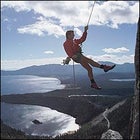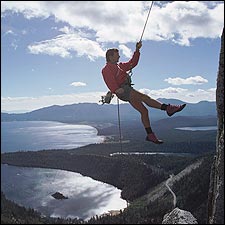WITH WALL STREET FIRMS using rock climbing and big-wave surfing to hawk banking services, it’s little surprise that health-insurance companies have repositioned their offerings for the adrenaline set. Blue Cross of California’s new Tonik health plan relies on dudespeak—”$#!@ that hurt! You landed wrong, really wrong”—and sports-event sponsorship to pitch standard medical coverage to what they call “the young invincibles,” Gen Y hucksters who are as likely to snap a wrist as they are to lack insurance.
Risky Business
A blown landing can cost more than your pride. Below is a list of common injuries and treatment costs from Dr. Dave Janda, director of the Institute for Preventative Sports Medicine. Note that these estimates are for noninvasive procedures. Go under the knife and you can expect to pay five to ten times as much.Broken Ankle=
,400 to ,000
Cracked Rib=0 to 0
Broken Wrist=
,200 to ,000
Dislocated Shoulder=,500 to ,000
Broken Collarbone=0 to
,000
Stitches= to 0 per stitch
climbing
 Hanging in for your lifestyle
Hanging in for your lifestyle
Tonik eliminates hidden fees—no surprise charges for X rays or lab tests in the ER—though its appeal is less about offerings and cost than packaging. With prices ranging from $64 to $123 per month for dental, vision, and full medical, the coverage is fairly standard. But with plan names like Thrill Seeker and Part-Time Daredevil and a Web site driven by slick graphics, Blue Cross is reaching out to young clients with a high five instead of a handshake. “They’re marketing to that segment in a way that’s very different,” says Robert Fahlman, COO of eHealthInsurance, the largest online broker in the United States. “That’s what’s significant here.”
Of course, there’s a reason Blue Cross is going to such lengths. The 13 million twenty-somethings in the U.S. who don’t have insurance constitute a market of roughly $1.5 billion. And despite the costs involved with common sports injuries—arthroscopic ACL surgery, which is performed more than 100,000 times a year in the U.S., can run as high as $30,000—young men are among the cheapest people to insure, thanks to good general health and an aversion to regular check-ups. That might explain why Tonik lacks maternity coverage but does offer discounted gym memberships.
“It’s about making sure the plan is simple and that the consumer has choices,” says Steve Synott, of Blue Cross of California. Course it is, bro. That’s why Tonik policyholders can choose from photos of mountain bikers, snowboarders, or blond models for their ID cards.


